LIVESTOCK IN CHINA

Yunnan pigsty China’s livestock herds are the largest in the world, far outstripping all of Europe combined and about comparable in size to all African nations combined. For example, in 2003 China had 49.1 percent of the world’s pigs, 22.5 percent of the world’s goats, and 7.5 percent of the world’s cattle. Converted into food production, China’s major livestock products in 2004 were pork (47.2 million tons), poultry eggs (28.0 million tons), cow’s milk (18.5 million tons), poultry meat (13.4 million tons), and beef and veal (6.4 million tons). Other meats of significant amounts were mutton, lamb, and goat. Major by-products were cattle hides (1.6 million tons), sheepskins (321,000 tons), and goatskins (375,000 tons). Honey (300,000 tons) and raw silk (95,000 tons) also were major products destined for the commercial market. [Source: Library of Congress]
According to the Library of Congress: Draft animals are important sources of motive power in rural areas. Draft animal numbers increased steadily from about 56 million in 1955 to 67 million in 1985 despite rapid increases in the number of tractors and trucks in rural areas. Animals that provide draft power for crop cultivation and rural transportation include water buffalo, horses, mules, donkeys, oxen, and camels. [Source: Library of Congress]
Water buffalo, pigs, cattle among most valuable possessions of rural families. Large animals such as horses, water buffalo, oxen and cattle are used in farming, particularly for plowing; are kept for wealth; and used as beasts of burden and sources of meat. Small livestock such as goats , pigs and sheep reproduce quickly and are sold for money, slaughtered for meat and raised for milk, skins and wool. Chickens, ducks and other birds produce eggs and meat. Many of these animals are also used in sacrifices and rituals. Villagers like to own their own their own plowing animals. It is difficult to borrow or share animals because often farmers have want to plow and perform other chores with them at around the same time. Pigs, goats and chickens are generally allowed to roam free around the village. They sometimes roam around inside huts where people live. Development officials try to discourage this as a precaution against disease.
Livestock in 2003: Cattle: 106 million; pigs: 465 million; sheep and goats: 300 million; chickens, ducks and geese: 14.2 billion. China is the world’s top consumer of meat and grain. The amount of meat consumed by the Chinese increased from 20 kilograms in 1965 to 50 kilograms in 2007. Livestock production has increased as demand for meat has increased as standards of living have risen. Many are fed soybeans as feed (See Meat Under Food, China's Food Shortages and the Rest of the World, Under Chinese Agriculture). China’s hundreds of millions of domestic animals take their toll on the environment (See Desertiication, Nature).
Websites and Resources
Good Websites and Sources: agrifoodasia.com ; Livestock Industry Products cn.countrysearch.tradekey ; China Livestock News en/chinalivestock
On Agriculture: Wikipedia article Wikipedia ; Wconomy Watch.com economywatch.com ; Products List and Links made-in-china.com ; China’s Ministry of Agriculture Data english.agri.gov.cn ; End of Agriculture in China, NPR Report npr.org ; Library of Congress Report from the 1980s lcweb2.loc.gov ; Can China Feed Itself? iiasa.ac.at/collections ; Essay on Agriculture and WTO Membership mtholyoke.edu ; Changing Agriculture and Farmers sociology.cass.cn
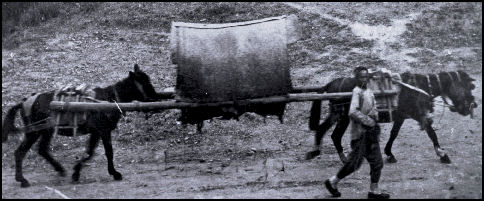
Covered wagon in the 1920s
Links in this Website: AGRICULTURE IN CHINA Factsanddetails.com/China ; AGRICULTURE IN CHINA UNDER MAO AND DENG XIAOPING Factsanddetails.com/China ; PROBLEMS FACED BY FARMERS IN CHINA Factsanddetails.com/China ; LAND SEIZURES AND FARMERS IN CHINA Factsanddetails.com/China ; CROPS IN CHINA Factsanddetails.com/China ; RICE AGRICULTURE IN CHINA Factsanddetails.com/China ; TEA AGRICULTURE IN CHINA Factsanddetails.com/China ; LIVESTOCK IN CHINA Factsanddetails.com/China ; SILK IN CHINA Factsanddetails.com/China ; POOR PEOPLE IN CHINA Factsanddetails.com/China ; RURAL LIFE IN CHINA 14 ; VILLAGES IN CHINAFactsanddetails.com/China ; MEAT, VEGETABLES, SWEETS AND FRUIT Factsanddetails.com/China ; DEFORESTATION AND DESERTIFICATION IN CHINA Factsanddetails.com/China ;
Kosher Foods in China
Even though most Chinese don’t know what it means and finding kosher food in China is next to impossible, China is the fastest-growing source if kosher-certified food in the world., with over 500 factories producing approved products — everything from meats to lipstick-shaped candy — as of 2008.
A single rabbi from New York flies to China and certifies food made at 300 plants. The rabbi told the Los Angeles Times his job is far than routine. Chinese can’t resist tugging on his beard, he said, and know little about making food kosher until he tells them. In Tibet he had turn down a request by herders who made the dairy protein caissen from yak milk because they produced it independently at home under circumstances that were hard to check out. At a fish factory he once check 27,000 fish by hand for three days straight to make sure all had fins and scales.
Cloning, Genetic Modification and Livestock Production in China
Tan Ee Lyn of Reuters wrote: “Chinese geneticist Du Yutao peers at an ultrasound monitor scanning the underbelly of a pregnant sow -- one of China's latest technological tools to feed its people better.The 20-odd hogs at this farm in Guangdong province in southern China are no ordinary pigs, but rather surrogate sows carrying cloned piglets. [Source: Tan Ee Lyn, Reuters, September 17, 2010]
With a population projected to grow to 1.44 billion by 2030 from 1.33 billion in 2009, according to World Bank figures, Beijing is hunting for cutting-edge technology to provide better quality food. Du's colleagues are cloning pigs at a laboratory an hour's drive from the farm. They remove DNA from skin cells taken from the ear of a prized boar and transfer them into pig egg cells cleared of their nuclei. The resulting embryos are surgically implanted into surrogate sows.
"Now we import valuable boars from Denmark and the United States. They are costly to buy, transport and susceptible to a lot of disease during transportation," said Du, head of cloning and genetic engineering at the Beijing Genomics Institute. "With this technology, we can import small numbers of pigs and mass produce them in China."
The United States is a world leader in producing GM crops and the Food and Drug Administration has already approved the sale of food from clones and their offspring, saying the products were indistinguishable from those of non-cloned animals. It is yet to rule on whether genetically engineered fish is safe to eat. But genetic modification of food and products from cloned animals meet with resistance in Europe.
In China, Du's department has set up a unit to commercialise cloning and she expects that meat from the offspring of cloned pigs will be on the Chinese market in "a few years". Her department is working with China Agricultural University on more muscular and less fatty transgenic pigs -- genetically modified rather than cloned -- by knocking out the MSTN gene that inhibits muscle growth. "We hope to get pigs with obvious traits of good muscles and faster growth ... a lot of lean meat and less fat," she said.
China's Agriculture Ministry has suggested an open approach in certificates issued for experimental planting of transgenic rice in recent years, according to Chinese press reports. Du said China's State Food and Drug Administration will need to approve products derived from cloned pigs and any transgenic produce before they are allowed on the market. While experts say meat from cloned animals is no different from naturally conceived animals, Du said more safety assessments were needed for transgenic products. "Transgenic animals have potential risks. It needs a long time to evaluate before they can get into market," she said. And international experts believe China can take a leading role in promoting the eventual acceptance of cloned animals.
Cattle and Dairy Cows in China
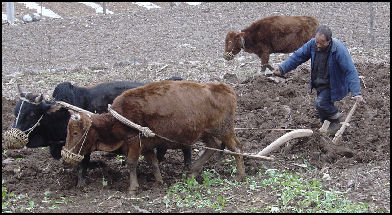
Cattle as plow animals
There are over 106 million cattle (2003), compared to 96 million in the United States. Cows have traditionally not been very common in China especially in the north. But that has changed. These days there are many dairy cows and beef cattle, especially in Inner Mongolia which has China largest grasslands.
China has worked hard to keep mad cow disease out of China. It has banned beef from countries where the disease has been reported. An outbreak of foot and-moth disease in Jinan district on Shandong Province sickened at least 48 cattle in December 2005. There were outbreak of the same disease in May of the same year.
China is the world’s seventh largest milk producer. It is increasing the number of cows by 1 million a year to meet demand. The increased demand for milk and dairy products has been triggered in part by a 1998 government directive for children to drink one glass of milk a day. Increased demand and relatively high prices has helped Chinese dairy farmers make a comfortable living. One farmer with four cows told the New York Times, “My income is very good. I can afford a televison and a sound education for my son. And it’s not very hard work.”
“The dairy and poultry sectors of the livestock economy grew most rapidly in the 1980s. Dairy cows numbered just under 500,000 in 1978 but tripled to around 1.5 million in 1985. Consumers with rising incomes demanded more fresh and powdered milk for infants and elderly people. A large part of this increased demand was met by individual farmers who were permitted to purchase and own their animals. The government supported increased milk output by importing breeding animals and constructing large dairies and processing facilities. [Source: Library of Congress]
The dairy business is being pushed in Inner Mongolia. An effort is being made to improve the quality of the cows (the average cow produced about 3,000 liters of milk a year compared to nearly 8,000 in the United States) and improve the food they are fed (traditionally they have been fed grain waste which does not produce high quality milk). If only 10 percent of Chinese consume what the average American consumes, China will need an additional three million cows to meet demand.
China’s dairy farming sector is centered in Inner Mongolia. China Mengniu Dairy and Yili Industrial Group, both based on Inner Mongolia, are China’s biggest milk suppliers with 2.5 million cows between them. In recent years the have imported cows from Australia that produce 7,000 liters a year, to meet demand.
See Food Under Life
Poultry in China
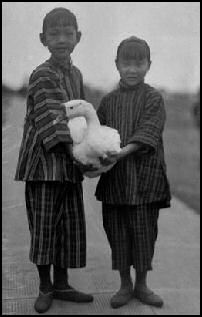
Children with a goose in the 1920s
China boasts the world’s largest poultry industry, with about 14.2 billion domesticated chickens, ducks and geese. There are some large industrial scale farms with more than a million birds but most are kept on of small family farms. Guangdong produces a half billion chickens a year. A lot of them end up in Hong Kong. Most poultry was still grown in farmyard flocks, but reforms encouraged individuals and groups of households to invest in confined feeding operations. Egg output, especially, increased rapidly in the 1980s.
The Deda plant in northeastern China near the North Korean border processes 330,000 chickens a day. A million chickens are sold by the Daijan company (China's largest chicken farm) a week. They are raised in feeding sheds that hold 20,000 birds and are ready or slaughter 49 days after emerging from their eggs and are carried away by conveyor belts.
The top exporters of broiler chickens in 2005 (metric tons): 1) Brazil (2.7 million); 2) the United States (2.3 million); 3) European Union (740,000); 4) China (331,000); 5) Thailand (240,000). [Source: U.S. Foreign Agricultural Service]
Howard Schneider wrote in the Washington Post, “For a sense of how this country’s changing demand for food is reshaping world markets, Liu Shuwen’s journey from street chicken vendor to poultry industrialist is a good start. There are the 24,000 hens he currently raises, triple what he had a few years ago. There’s the expansion to 60,000 he is planning. Then there’s the feed factory that’s under construction, where Liu and his partner will add to growing world grain demand by mixing hundreds of tons of soybeans and corn a year into a recipe he feeds his chickens and sells to other farmers. [Source: Howard Schneider, May 22, 2011]
“We are keeping up with the world,” said Liu, who migrated to Beijing from the countryside 30 years ago. He once roamed the streets selling baby chicks out of a bucket. Then he and a veterinarian named Zhang Huaicheng took over a bankrupt state-owned chicken farm. The pair specialize in brood hens, incubating millions of eggs a year into hatchlings for sale to other farmers who want to produce eggs or broilers.
For entrepreneurs such as Liu Shuwen, it is a trend that has taken him from poverty to the top of an industrial-scale enterprise. As he strolls through a warehouse of incubators, crates full of chicks peep and squawk as farmhands prepare to ship a load to the province of Inner Mongolia. The clamor is deafening. “The product keeps selling,” he said, “so we’ll keep expanding.”
Bird Flu, See Diseases, Health
Foie Gras in China
China is home the world’s largest foi grass factory
There lots of geese in Hepu County, just north of Vietnam. Entrepreneurs are attempting to cash in their presence by launching the world's largest foie gras production facility. The primary investor, a former circus acrobat that made a fortune in real estate, has sunk $24 million into the World Goose Foodstuff Company, which has purchased high-tech feeding processing equipment capable of producing 1,000 tons of foie gras a year. Many people are skeptical about the endeavor. Making quality foi gras takes great skill and adherence to exacting methods.
Ducks
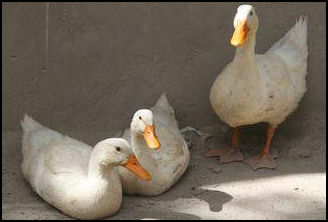
Billions of ducks are raised in China for their meat. The majority of them are white Peking ducks (introduced to the United States from China in 1870) raised on small farms with ponds. Domestic ducks sometimes breed with mallard ducks producing strange-looking hybrids.
Ducks are relatively easy to raise. The are tough and relatively free of disease and parasites. They need only simple housing and can survive without swimming water if need be. The eggs are easily hatched and there is relatively cheap. To fatten them up they are sometimes force fed like foie gras ducks.
Ducks do well in China because they are adaptable animals and they do well in cold climates. They have a thick layer of down for protection and their web feet have no nerves so they don’t feel the cold in icy water. The cloaca of male ducks the male cloaca us fashioned into a kind of quasi penis.
Ducks will eat a wide variety of food as anyone who has thrown bread in a ducks pond knows. Wild ducks often eat things like wild celery. In China, domesticated ducks are often fed silkworms.
Ducks have traditionally been herded from one field to another to eat leftover rice. After they are slaughtered the ducks are plucked and gutted, rubbed with red chiles and hung to dry on a fence in the sun.
Ducks can carry viruses that are not harmful to them but can kill chickens and sometimes people. In Japan the ducks are banned because the presence of a bird influenza was found.
Sheep, Goats and Wool
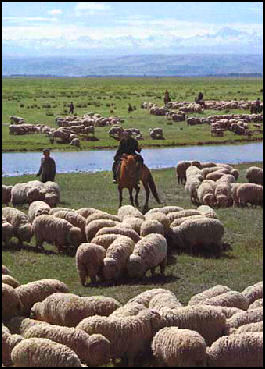
Sheep in Inner Mongolia
China is the world’s leading consumer of raw wool (306,000 tons) and the world's largest producer of sheep. There are over 300 million sheep and goats, compared to 8 million in the United States. The number of cattle, sheep and goats tripled between 1950 and 2003. Sheep and goats are China's most important grazing animals. Most of these animals are bred in the semiarid steppes and deserts in the north, west, and northwest. The number of sheep and goats has expanded steadily from about 42 million in 1949 to approximately 156 million in 1985. Overgrazed, fragile rangelands have been seriously threatened by erosion, and in the late 1980s authorities were in the midst of a campaign to improve pastures and rangelands and limit erosion. [Source: Library of Congress]
According to the Guinness Book of Records, it was home to 240.5 million sheep in 1995.
Australia is trying to market its wool in China by promoting a $150 washable suit using the Chinese movie star Yin Xiaotian,. China is already Australia largest wool buyer, buying 60 percent of Australia’s exports.
Image Sources: 1) Lottie Moon; 2) Harvard Public Health; 3, 5) Nolls China website http://www.paulnoll.com/China/index.html ; 4) Frog in a Well blog; 6) Bucklin archives ; 7, 8) University of Washington; 9) Julie Chao
Text Sources: New York Times, Washington Post, Los Angeles Times, Times of London, National Geographic, The New Yorker, Time, Newsweek, Reuters, AP, Lonely Planet Guides, Compton’s Encyclopedia and various books and other publications.
Last updated January 2013
